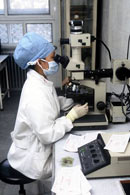



Keeping track of the patterns of drug-resistant tuberculosis throughout the world is difficult. Firstly, the data available are limited because some countries, particularly countries with a high TB burden, do not have enough laboratories to conduct tests, or systems to keep track of TB cases. Secondly, the quality of drug susceptibility tests is not consistent and needs to be better ensured, particularly for resistance to second-line anti-tuberculosis drugs.
The Global Project on Anti-tuberculosis Drug Resistance Surveillance was set up in 1994 by the WHO, the International Union Against Tuberculosis and Lung Disease and other partners. Its aims are to estimate the levels of resistance to anti-TB drugs throughout the world and see how these change with time, to develop plans to prevent and tackle drug resistance and to evaluate the progress of these plans.
The project assembles a network of 26 “supra-national reference laboratories” (SRLN) that give practical and technical support to over 150 national laboratories worldwide. The supra-national laboratories are the backbone for surveillance and since 1994, the Global Project has collected data on resistance to first-line anti-TB drugs from areas representing almost half of the world’s TB cases. The main priorities for the network are to cope with the demand for laboratory services and to obtain regular funding.
New methods have been developed that can diagnose MDR-TB quickly, and although they have not yet been fully validated, some countries are already using them to identify cases of MDR-TB. If successful, these new methods would be extremely helpful to gather more information on drug-resistance. At the moment there are no quick methods that can detect resistance to second-line drugs.
This text is a summary of: WHO,
![]()
Fourth Global Report (2008), Chapter 4: Discussion, Overview (p.
78), Chapter 4: Discussion, SRLN (p. 87-89)

This summary is free and ad-free, as is all of our content. You can help us remain free and independant as well as to develop new ways to communicate science by becoming a Patron!